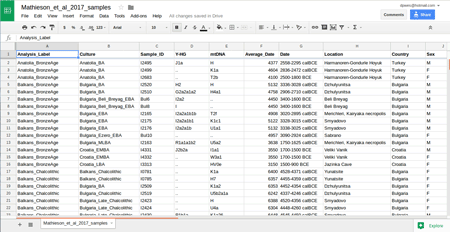
UWAGA!!! BARDZO WAŻNY WPIS!!!
Dla mnie ten wpis to kolejny dowód na:
a) śmierć „południowej drogi R1a”, bo brak jest R1a na Bałkanach, Anatolii, itp,
b) śmierć Anatolii jako kolebki tzw. PIE, czyli także i języka tzw. PIE,
c) coś dziwnego dzieje się rolnikami z Bałkanów, bo okazują się wcale nie być aż tak anatolijscy, tylko 2000 lat wcześniej zmieszani z hodowcami ze stepu,
d) no i zaczyna się dyskusja nad około 10,500 starym R1a na stepie (Vasilievka) i w Karelii,
e) no i to samo dotyczy R1b znalezionego w Dereivka, ale przede wszystkim na zachód od stepu… czyli R1b jako, że mieszało się wcześniej z innymi ludami, nie tak jak R1a… to zatraciło np. wiele ze swojego… hm… „pierwotnego?” języka…
Folker said…
I find extremely interesting: „early farmers from southern Greece are not descended from the Neolithic population of northwestern Anatolia that was ancestral to all other European farmers”.
May 10, 2017 at 5:07 AM
Gioiello said…
„intermittent steppe ancestry” intermittent doesn’t mean „massive”, I’d say it means „a little” let that I say that, being this word of Latin origin. good-by R-L51 from the East. good-by Samara
May 10, 2017 at 5:15 AM
bellbeakerblogger said…
‚Intermittent’ sounds like pockets of foreigners. Varna elite = Lower Volga? Question is if they are like later Yamnaya?
May 10, 2017 at 5:57 AM
batman said…
According to geography and the alledged bifurication of R1, Varna ‚elite’ should rather relate to a West Side Story of Lower Vistula.
May 10, 2017 at 6:30 AM
Suevi said…
I1819 (8825-8561 calBCE (9420±50 BP, Poz-81128), Ukraine_Mesolithic, Vasil’evka) – R1a
May 10, 2017 at 7:14 AM
Romulus said…
LOTS OF R1B IN MESOLITHIC BALKANS
May 10, 2017 at 7:28 AM
Roy King said…
Amazing! Much R1b1a in Balkans!
May 10, 2017 at 7:28 AM
Arza said…
@ EastPole
Ukraine Eneolithic 3500 BCE I4110 from Dereivka looks like a modern Balto-Slav (Figure 1.)
May 10, 2017 at 7:28 AM
Karl_K said…
It’s nice to have enough samples that you can actually get a sense of the variety of mixing between cultures, and the regional differences in genetics. Lots of unexpected stuff here.
May 10, 2017 at 7:49 AM
Slumbery said…
About a much debated topic: it looks like GAC had no „Steppe”, it appears as a typical farmer population, but with elevated (25%) WHG. Also Comb Ware is EHG and assimilating the previous WHG-heavy groups in the Baltic.
May 10, 2017 at 7:58 AM
Karl_K said…
@Slumbery And some Comb Ware were close to 100% EHG. Very interesting that they were so isolated for so long.
May 10, 2017 at 8:03 AM
Romulus said…
Varna man belonged to Y DNA CT, what a let down, guess his golden condom ended that Y line. Other Varna are 2x G2a and 1 R1.
May 10, 2017 at 7:59 AM
Davidski said…
@Karl_K R1a is an EHG marker, native to Eastern Europe. It did not migrate there with CHG.
May 10, 2017 at 9:21 AM
irjhar007 said…
R1a is an EHG marker, native to Eastern Europe
To be neutral you can’t connect autosome with Hgs directly . But obviously we are not worried about M417- clines , they were there all over Eurasia from Meso to Early Neo , we will have to see how the pattern of M417 + emerges. I also think Meso India will also show lots of R1a M417 – , but again it will not matter much to the IE question, to which M417 can be somewhat faithfully connected. Now it turns for the Mycenaean and Maykop , very very crucial and of course India.
May 10, 2017 at 9:30 AM
Davidski said…
@Nirjhar I also think Meso India will also show lots of R1a M417-. You’re totally nuts. Take some pills and go and lie down for a while.
May 10, 2017 at 9:35 AM
http://eurogenes.blogspot.co.uk/2017/05/the-genomic-history-of-southeastern.html
Wednesday, May 10, 2017
The genomic history of Southeastern Europe (Mathieson et al. 2017 preprint)
Over at BioRxiv at this LINK:
Abstract: Farming was first introduced to southeastern Europe in the mid-7th millennium BCE – brought by migrants from Anatolia who settled in the region before spreading throughout Europe. However, the dynamics of the interaction between the first farmers and the indigenous hunter-gatherers remain poorly understood because of the near absence of ancient DNA from the region. We report new genome-wide ancient DNA data from 204 individuals-65 Paleolithic and Mesolithic, 93 Neolithic, and 46 Copper, Bronze and Iron Age-who lived in southeastern Europe and surrounding regions between about 12,000 and 500 BCE. We document that the hunter-gatherer populations of southeastern Europe, the Baltic, and the North Pontic Steppe were distinctive from those of western Europe, with a West-East cline of ancestry. We show that the people who brought farming to Europe were not part of a single population, as early farmers from southern Greece are not descended from the Neolithic population of northwestern Anatolia that was ancestral to all other European farmers. The ancestors of the first farmers of northern and western Europe passed through southeastern Europe with limited admixture with local hunter-gatherers, but we show that some groups that remained in the region mixed extensively with local hunter-gatherers, with relatively sex-balanced admixture compared to the male-biased hunter-gatherer admixture that we show prevailed later in the North and West. After the spread of farming, southeastern Europe continued to be a nexus between East and West, with intermittent steppe ancestry, including in individuals from the Varna I cemetery and associated with the Cucuteni-Trypillian archaeological complex, up to 2,000 years before the Steppe migration that replaced much of northern Europe’s population.
Mathieson et al., The Genomic History Of Southeastern Europe, bioRxiv, Posted May 9, 2017, doi: https://doi.org/10.1101/135616

See also…
Globular Amphora people starkly different from Yamnaya people
The Bell Beaker Behemoth (Olalde et al. 2017 preprint)
Posted by Davidski at 12:04:00 AM Czytaj dalej





